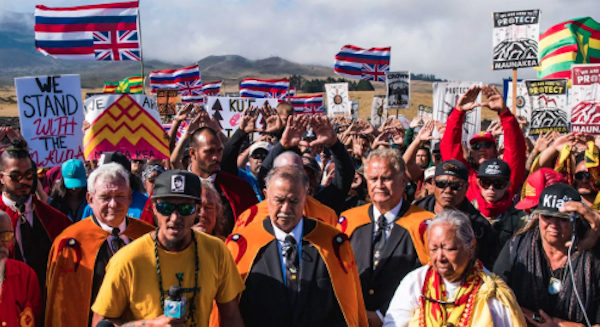
The nearly 14,000-foot high volcano is already home to 13 large telescopes dating back to the 1960s with a history of opposition. TMT opponents say the $1.4 billion TMT must not be the 14th. When hundreds of Native Hawaiians gathered to block construction vehicles, Gov. David Ige showed initial restraint, but by the third day, police and Hawai'i's National Guard were dispatched, key roads closed, a state of emergency declared, and at least 34 kūpuna (elders), were arrested in an emotional exchange with Department of Land and Natural Resources officers.
TMT is the proposed development of a collaboration between seven institutes and organizations from Canada, China, India, Japan and the U.S. with major funding from the Gordon and Betty Moore Foundation. Mauna Kea is considered one of the world's best places to gaze into deep space, and for Native Hawaiians, one of their most sacred places. Opponents of TMT (who call themselves kia'i, or "protectors") have said their struggle is about much more than a telescope. They see this as a fight to stop desecration of wao akua (realm of gods) and brazen disregard for the will of the Kānaka Maoli, or Native Hawaiians.
For more than a century, outside forces — from Christian missionaries and Western business interests to corporate developers in real estate and tourism — have exploited Hawai'i and reaped profits by dispossessing people from the land. At the same time, the United States government, which supported the overthrow of the Hawaiian Kingdom in 1893, has designated Hawai'i as a strategic platform to project economic, political and military power across the Pacific and into Asia.
Building on a History of Resistance
In the first two weeks of resistance, the main encampment has organized classes taught by professors on Hawaiian history, science and language, as well as health care, legal counsel and other assistance. With donated food and labor, protectors have the capacity to feed the estimated 1,500-2,000 people who gather on the mountain on any given day.
The protectors who chained themselves to cattle grates on the access road that winds to the summit of Mauna Kea have accepted bitter cold restless nights in thin air, scorching daytime heat, rain and possible arrest. For them, this isn't about just a telescope. It's part of a greater struggle against a long history of dispossession.
Some of these same protectors risked their lives to stop decades of live-fire testing by the U.S. Navy on the island of Kaho'olawe, to demilitarize Mākua Valley on the island of O'ahu, and to continue to resist ongoing weapons testing and training at an Army installation as large as the island of Guåhan (Guam) called Pohakuloa Training Area, located just a few miles away from the TMT resistance.
One of those protectors is Earl DeLeon, a tall, sturdy man with powerful, expressive hands. DeLeon oversees a group of volunteers called the kapu aloha crew who are tasked with ensuring the safety of all gathered on the mountain.
DeLeon, who traveled to North Dakota three years ago to offer his support to Standing Rock protests, says, "We know that the ultimate [goal] of solidarity is to stop the desecration of the land and the disenfranchisement of the people who come from the land."
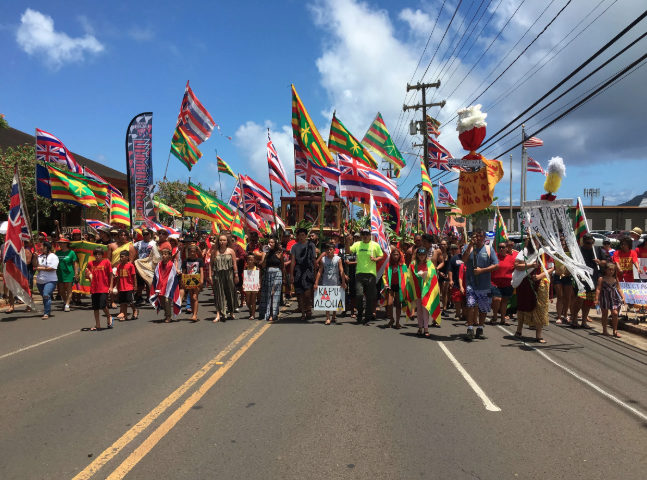
"Our sacred site is our sacred site and there is no compromise," DeLeon says, calling for TMT investors to build their telescope at the project's alternate site in Spain's Canary Islands.
DeLeon articulated the philosophy of their resistance in this way: "We stand in kapu aloha which means we hold ourselves to the highest level of love. The highest level of restraint. The highest level of peace. The highest level of trying to disseminate into this planet nothing but positive vibes that are going to huli (change) this system of destruction, to change the mentality of 'might is right' all the time."
Women Resist Desecration of the Land
Shortly after returning from Mauna Kea, Joy Enomoto, an organizer with the group Women's Voices Women Speak, explains how TMT, like current U.S. military construction projects in Okinawa, Japan, and the U.S. territory of Guam are a "basic template for how the state is attempting to justify its increasing desecration of sites held most sacred by native people."
Each of the three sites, she adds, are ecologically and culturally significant, yet have U.S. military installations within or around them. Each of the struggles, Enomoto says, represents another step toward liberation from the U.S. and other foreign interests.
She stresses the central role LGBTQ activists and women play in each struggle, leading direct actions, standing strong as they face police and security forces on the front lines and behind the scenes, coordinating logistics and legal strategies, solidarity movements, media contacts, and making sure people are cared for, sheltered and fed.
University of Hawai'i-Mānoa political science professor Noelani Goodyear-Ka'ōpua also just back from Mauna Kea said, "Whether it is firing ranges in Litekyan [also called Ritidian], the expansion of U.S. military bases in Henoko [Okinawa], or the construction of the TMT on Mauna Kea in Hawai'i, what we are talking about is the forced dislocation of Indigenous people from our lands and the enclosure of these lands by militarized fences and forces that aim to keep us out."
The struggle against "imperialism and military occupation," she said, has created strong bonds of solidarity and support between brave, Indigenous women. The impacts colonization and militarization (sexual and domestic violence, disruption of family life, economic hardships, to name a few) are examined in new books like Goodyear-Ka'ōpua's Nā Wāhine Koa and Akemi Johnson's Night in the American Village.
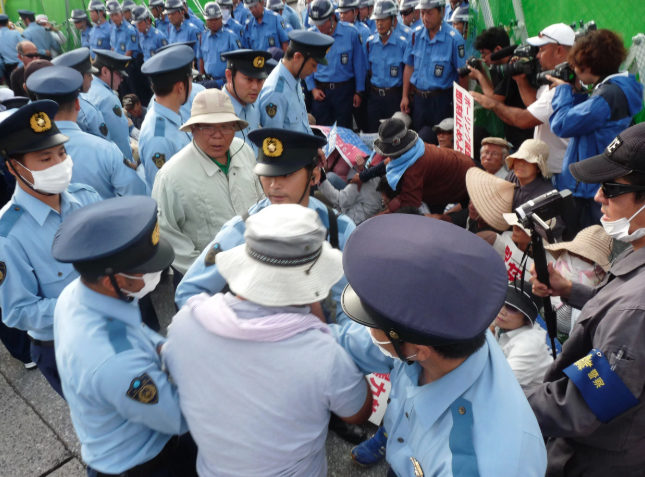
In an open letter to Hawai'i's governor dated three days after current TMT resistance began, two local Hawai'i activists who, like the governor, share Okinawan ancestry, linked the struggle against imperialism in both places, invoking Hawai'i's concept of aloha 'āina (love for the land) and the Okinawan value nuchi du takara (all life is a treasure) even as both are disregarded in order to accommodate the demands of development.
The battle to stop new U.S. military installations from being built in northern Okinawa, a struggle that is reflected in some ways on Mauna Kea, has continued for more than 15 years with multiple protest encampments staffed daily year-round. Okinawans and their allies are fighting on land and at sea to prevent the construction of U.S. military installations on reclaimed land at Cape Henoko/Oura Bay and in the nearby Yanbaru Forest.
Both are sites of rich biodiversity, from rare corals and marine life, to birds, insects, amphibians and plants endemic to the region. Okinawa's struggle to stop the construction has been marked by prolonged court battles, massive public demonstrations, and daily sit-ins to physically impede or slow construction of new U.S. military installations. Okinawan elders, many in their 70s and 80s, are regularly intimidated, threatened and hauled away by Japanese security forces while American officials claim the battle is an internal matter between Okinawan protesters and Japan, one which they cannot comment on.
U.S. and Japanese officials have been unresponsive to Okinawa's sustained, unwavering demands to abandon new base construction even as they insist they are committed to "reducing the burden" of Okinawa's outsized military presence by relocating around 4,000 U.S. Marines to Guam and elsewhere.
The planned transfer of Marines from Okinawa has led to a flurry of new military construction projects on Guam and the neighboring Commonwealth of the Northern Mariana Islands (CNMI). One of the most contested is a new Marine Corps live firing range training complex in an ecologically fragile and culturally important forest area called Tailå'lo above Litekyan, one of Guam's most important cultural and natural protected areas, and with other military sites on Tinian and Pagan Islands in the CNMI.
As ancient artifacts continue to be discovered, Guam's governor and opponents of the military build-up have called for a pause in the military construction, with many wanting it stopped completely. Like Hawaiians on Mauna Kea and Okinawans at Henoko and Takae, Guam's Indigenous Chamorro people are fighting construction projects forced on them by outsiders.
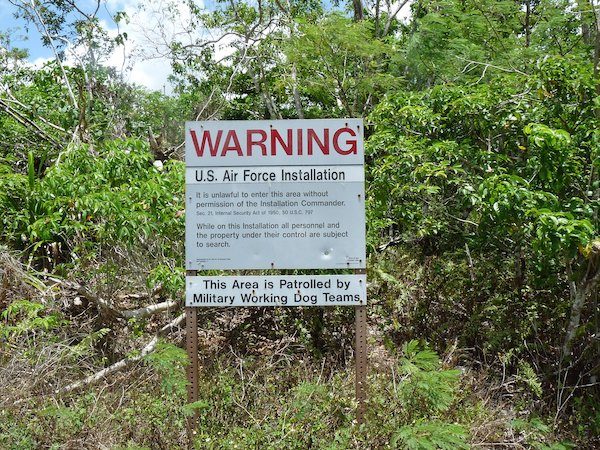
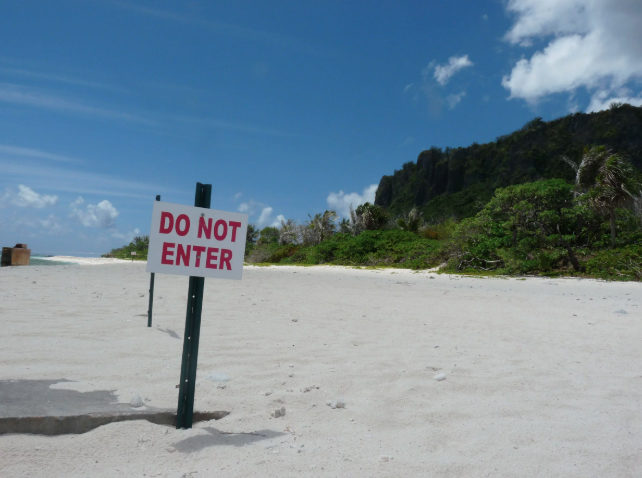
At a recent demonstration on Guam intended to show solidarity with Mauna Kea protectors, Maria Hernandez of the group Prutehi Litekyan said, "We see so many parallels in their issue in connection to our fight trying to preserve Litekyan from being turned into a firing range." She continued, "It should be enough to say this area is sacred. We are the indigenous people of this island.... That should be enough to not put something on our sacred land."
Chota Takamine, an Okinawan journalist, told Truthout, "I can see a similarity in these three struggles in the autonomy of local minority groups being invaded by the United States. Of course, people in Okinawa, Guam, CNMI and Hawai'i can support each other." He urges U.S. citizens and the media to take responsibility for what the U.S. government and military are doing in other people's homelands.
Okinawa activist Shinako Oyakawa sees a troubling connection between her home island, Guam, and Hawai'i. "The colonizer treats [our] land as if it's their land, insisting they have rights over it. However, from the Indigenous perspective, the land and ocean have been illegally and forcibly taken to be used to the colonizer's benefit."
These resistance movements in Hawai'i, Okinawa and Guam/CNMI continue even as newly confirmed Secretary of Defense Mark Esper, a former Raytheon lobbyist, has called for new bases and "new capabilities" throughout Asia and the Pacific. These demands all but guarantee a continuing battle over the protection of vital water resources, biodiverse coral reefs and rivers, sacred forests and volcanic peaks, and Indigenous cultures and traditions.
Writing from the University of Guam, assistant professor of Chamorro studies Michael Lujan Bevacqua told Truthout, "In each of these movements, we can see culture in its most radical and beautiful form," adding that, for Indigenous people, culture is more than "anthropological trinkets or flavors for the blandness of modern life." There is value, Bevacqua said, in not transforming, militarizing and selling things off.
"The sacredness, that depth of value, is something missing from much of today's world," Bevacqua said. "It's not silly spirituality or outdated epistemology that drives those ideas [in] Litekyan, Mauna Kea or Henoko as being sacred and worthy of being defended, but it comes from a narrative born of intimacy with the Earth, and driven by sustainability, the connections between generations past and future, rather than just a focus on the present and immediate gain."
What we see in Litekyan, Mauna Kea and Henoko, Bevacqua said, "is the way culture can be a critical reminder that certain things should not be for sale, certain things should not be primed for the marketplace."
About the author
Jon Letman is a freelance journalist on Kauai. He writes about politics, people and the environment in the Asia-Pacific region. Follow him on Twitter: @jonletman.



Comment: For more information on the ongoing issue with the Thirty Meter Telescope on the top of Mauna Kea: Giant Hawaii telescope construction halted over unrest